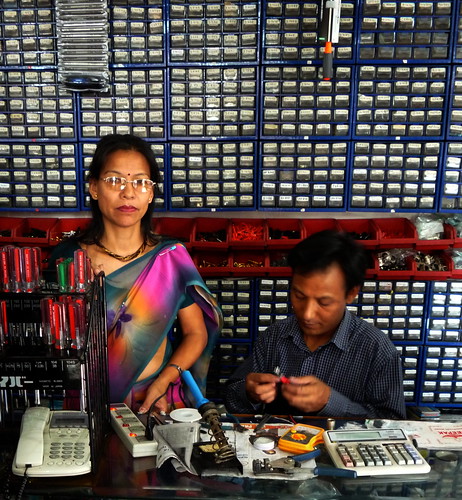 XLR microphone cables aren’t easy to come by in Kathmandu. But if you ask around enough places in New Road, the commercial neighborhood of winding alleyways and cubby-hole malls, you might eventually be directed to the fifth floor of a shopping center where Shiv Electronics Concern sells TV and computer parts. They also assemble XLR cables to custom lengths.
XLR microphone cables aren’t easy to come by in Kathmandu. But if you ask around enough places in New Road, the commercial neighborhood of winding alleyways and cubby-hole malls, you might eventually be directed to the fifth floor of a shopping center where Shiv Electronics Concern sells TV and computer parts. They also assemble XLR cables to custom lengths.
Shiv Electronics Concern is a little window into the shabby conditions for doing business in Kathmandu these days. When I visited it was manned by Santa Shakya and her brother Krishna, who's working on one of my cables. The shop was started by their grandfather 27 years ago. Business is down, according to Santa, because of political problems, “bad protocols,” and general mismanagement in the country. On top of that, the market’s been flooded with cheap parts from China, which are sold indiscriminately on the street, Santa said. The Concern mostly sells Taiwanese and Japanese parts, which are more expensive.
While Krishna was wiring the cables, the lights went out a few times, causing him to mismatch a pair of wires, which he fixed when the lights came back on. But this was in the same week that The Nepal Electricity Authority announced that power outages, or “load-shedding” in the local parlance, will reach up to 35 hours a week. The
 daily newspapers published a handy chart of outage times, according to your neighborhood.
daily newspapers published a handy chart of outage times, according to your neighborhood.As for cheap Chinese merchandise, you don’t have to go far in New Road to find it in abundance. Just around the corner from The Concern is a storefront selling counterfeit Shure SM-58 microphones. To locate the SM-58, a stout vocal mic used by rock and roll bands everywhere, look for a large straw basket of ginger root and an old man cutting his toe nails. Turn a corner and you’ll find a whole line of Shure mics up on a shelf to your left. Here an SM-58 only costs 900 Rupees, which is just a hair under 13 US dollars. In New York it sells for over a hundred bucks.
These microphones are counterfeit of course, and the salesman wasn’t at all shy about advertising that. “These Chinese export quality SM-58’s sound just as good as the world class ones. But the real ones cost 10,000 Rupees, and you can’t get them in Kathmandu anyway.” He went on to explain that there are in fact three levels of counterfeit SM-58’s: one costing 900 rupees, one 1500, and one 2500. You can’t tell the difference by looking at it straight ahead. But if you look into the bottom of the mic you can distinguish the low, medium, and high quality fakes. See if you can tell which one’s 2500 rupees. Hint: look for the gold plated pins.

0 comments:
Post a Comment